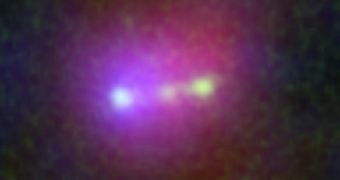An international team of astronomers recently made an impressive discovery, when they used three highly-capable telescopes to image an extremely-distant cluster of three galaxies caught in the act of merging. All objects lie within the same blob of primordial hydrogen gas, and form a structure about the size of Milky Way.
While this size may not seem all that impressive – seeing how our galaxy is of medium size – it is in fact absolutely stunning when considering that the cluster lies 13 billion light-years away from Earth. This means that we are seeing them how they looked when the Universe was just 800 million years old.
The distant object has been observed before, and experts named it Himiko, in honor of the legendary queen of ancient Japan. However, recent observations determined that the object was actually made up of three separate galaxies.
This finding is very important because it solves an issue that arose when Himiko was first detected as a single, large galaxy; astronomers were wondering how such a massive structure could have developed so early in the history of the Universe.
The new study was conducted using the international Atacama Large Millimeter/submillimeter Array (ALMA) telescope, at the Llano de Chajnantor Observatory, in Chile, the NASA/ESA Hubble Space Telescope and the NASA Spitzer Space Telescope.
Data were collected in radio, optical/ultraviolet and infrared wavelengths, respectively. Details of the study will appear in a paper scheduled for publication in the December 1 issue of the esteemed Astrophysical Journal.
“This exceedingly rare triple system […] provides important insights into the earliest stages of galaxy formation during a period known as 'cosmic dawn,' when the Universe was first bathed in starlight,” says research team member Richard Ellis, from the California Institute of Technology (Caltech).
“The new observations revealed that, rather than a single galaxy, Himiko harbors three distinct, bright sources, whose intense star formation is heating and ionizing this giant cloud of gas,” explains University of Tokyo associate professor of astronomy Masami Ouchi, the leader of the research.
The Spitzer Space Telescope is managed by the Jet Propulsion Laboratory at Caltech for the NASA Science Mission Directorate, in Washington DC. The ALMA interferometer is operated by the US National Radio Astronomy Observatory (NRAO) for North America, and by the European Southern Observatory (ESO) for Europe.
Infant Galaxies Seen Merging Near 'Cosmic Dawn' from NRAO Outreach on Vimeo.
Video credits: NRAO / AUI / NSF; NASA / Hubble / Spitzer / NAOJ / Subaru
 14 DAY TRIAL //
14 DAY TRIAL //